When you buy through our links, we may earn an affiliate commission.
Whether you're soft-spoken or have some pretty aggressive vocals, you want to be sure you have a mic that can handle your vocals.
We covered what makes a microphone a good mic for vocals. Between mic type, polar pattern, and frequency response, we'll dive into everything that will make a recording session go smoothly.
They were picked due to their excellence, versatility, durability, fidelity, and value. This will give you a good start in your journey to make better recordings according to your budget.
Some of these mics are pretty affordable, but we made sure to include some picks for the studio professional looking to upgrade a mic or two.
Quick Summary of the Best Microphones for Vocals
- Austrian Audio OC818 (Our Top Pick for Studio Mics)
- Lauten Atlantis (Best for Female Vocals in Studio Setting)
- Lewitt PURE TUBE (Best HQ Tube Tone)
- Neumann U67 Reissue (Best High-End Mic)
- Shure SM7B (Best Broadcast Mic for Podcasting & Journalists)
- Aston Microphones Spirit (Best XLR Under $330)
- Beyerdynamic M160 (A Versatile Mic for Vocals & Drum Overheads)
- Shure SM58 (Best Shure Mic Under $100)
- Audio-Technica AT2020 (Best Audio Technica Mic Under $100)
- Lewitt MTP W950 (Best Studio Versatility)
- C7 Supercardioid Condenser (Best AKG Mic)
- Rode S1 (A Rode Favorite)
Best Microphone for Vocals
1. Our Top Pick for Studio Mics – Austrian Audio OC818
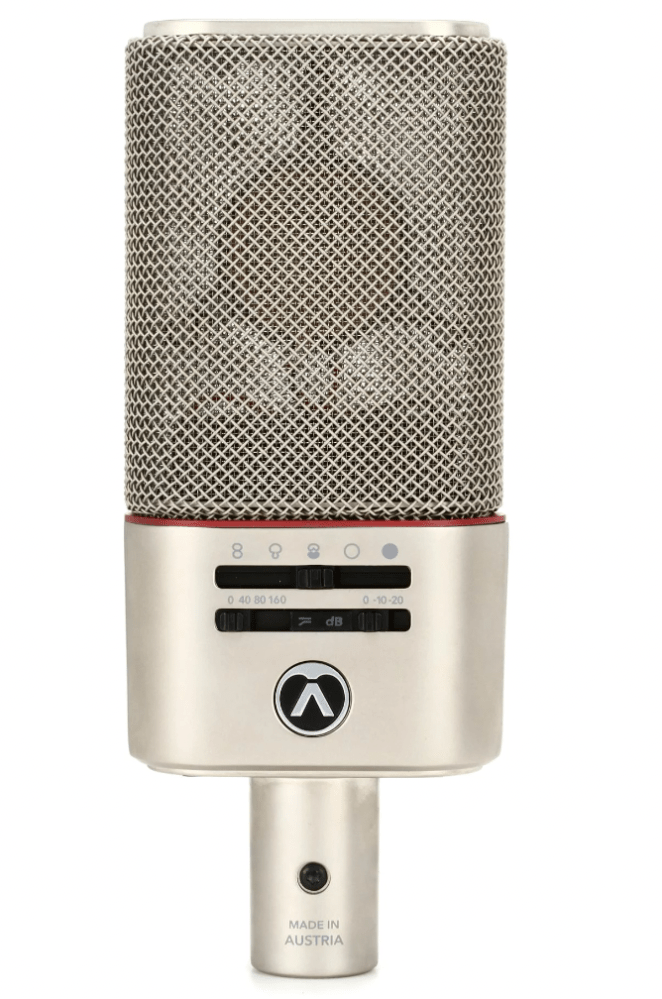
SPECS
- Type: Condenser microphone
- Pattern: Multipattern
- Connectivity: XLR
The Austrian Audio studio mic was formed by former AKG employees who, when the factory closed, took their legendary technology and experience and executed it to the next level.
A large diaphragm, multi-pattern mic, it’s not just exceptional on vocals—and any other source you may choose—but it comes with software plugins that allow you to shape the recorded sound after you’ve recorded it by changing the polar patterns per frequency.
In addition, they built in a special output on the back of the mic that uses a proprietary cable that allows stereo recording. What? Yup. And the best part is the quality and build are just incredible.
It has a frequency range of 20Hz to 20kHz and a sensitivity of -10 dBV/Pa (316 mV). It also has a low self-noise of only 9.5 dBA for clean and clear recordings, even in quiet environments.
Users also love using it for drum overheads, so if you're also a drummer, you'll enjoy this versatile mic. It includes a shock mount, case, and accessories.
Want to Read More About Microphones? See Our Picks for Affordable Boom Mics.
2. Best for Female Vocals in Studio Setting – Lauten Atlantis
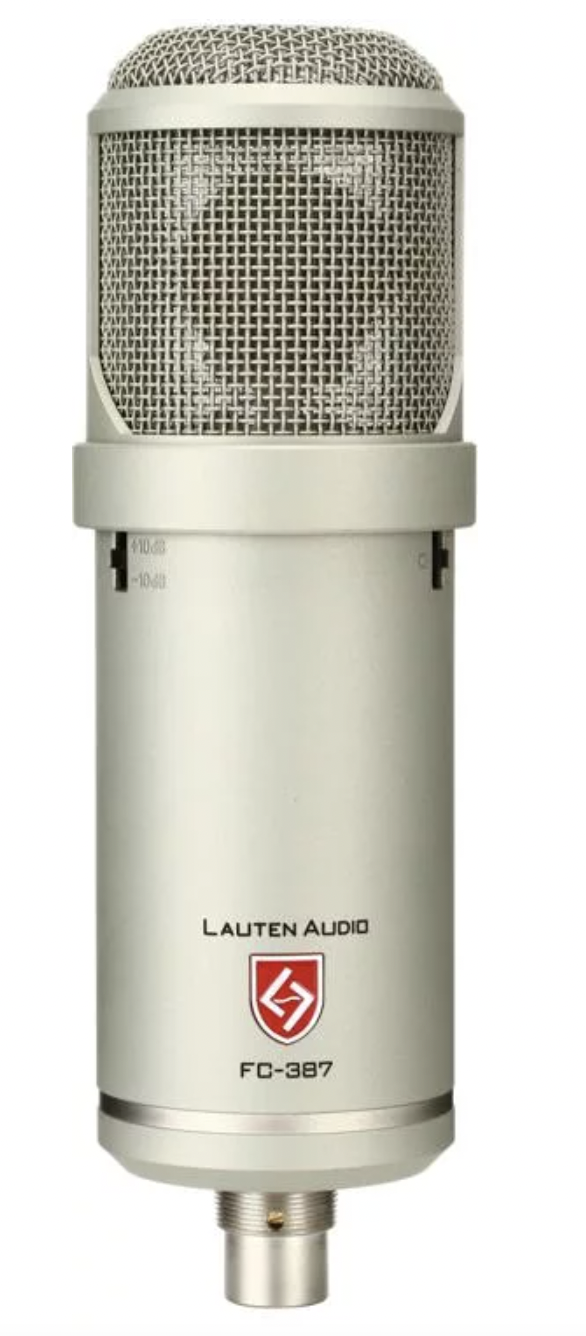
SPECS
- Type: Condenser microphone
- Pattern: Cardioid, Omni, Figure-8
- Connectivity: XLR
The Atlantis is a large diaphragm, multi-pattern mic in the classic style of a U47 FET transducer. It’s terrific on vocals, drums, guitars, and just about anything you can throw at it, especially female vocals.
It can take high SPL (volume) without breaking up and has a nifty voicing switch for flat, modern, or vintage. The vintage setting cuts high frequencies above 5k, and the modern accentuates those frequencies.
It’s not cheap at around $1,700, but it’s well worth it due to its high fidelity, versatility, and it’s build quality - making it the #1 best microphone for vocals.
This mic has a durable metal construction and comes with a shock mount and a box for storage. And fair warning, everyone who uses this mic will fall in love. The sound quality is great when recording all genres.
Want to Learn More About Podcast Microphones? See Our Favorite XLR Podcast Mics Here.
3. Best HQ Tube Tone – Lewitt PURE TUBE

SPECS
- Type: Condenser
- Pattern: Cardioid
- Connectivity: XLR
The Lewitt Pure Tube is a new studio microphone that is optimized for vocal recordings. The cardioid-based pattern will really home in on your voice and record your vocals how you intend for them to sound.
They say that you pay for quality, and this microphone is a pure example of just that; it has an ultra-low self-noise of 7db, which challenges some of the best-considered microphones in the recording game.
The microphone itself provides a timeless premium sound with a twist, it has a revolutionary new circuit that is free from capacitors and semiconductors in the signal path.
The Pure Tube will enhance your vocal with a warm, rich color without the loss of clarity, and with a frequency response of 20Hz-20kHz, there won’t be any frequency from your voice that will be missed when recording with this microphone.
With the purchase of the Pure Tube, you will also acquire a Microphone Mount, 7-pin XLR for PURE TUBE, and a transport bag should you be moving in between studios.
In addition to all these exciting add-ons, this microphone also comes with a 10-year Lewitt warranty, giving you security in the product you’re purchasing.
For all the vocalists out there looking to improve the quality of their recordings, look out for the Pure Tube Microphone from Lewitt.
4. Best High-End Mic – Neumann U67 Reissue
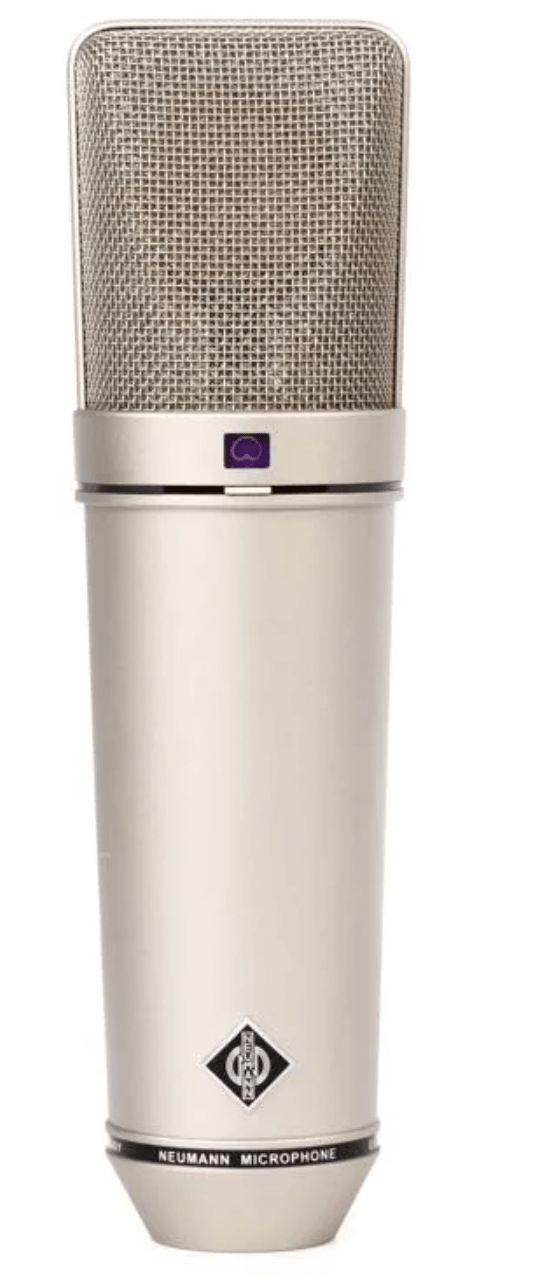
SPECS
- Type: Tube Condenser microphone
- Pattern: Cardioid, Figure-8, Omnidirectional
- Connectivity: XLR
At $7,500, the U67 is the most expensive mic on this list, but many consider the original the pinnacle of studio microphones. The reissue is almost identical.
The legendary mic works great for male and female vocals as well as acoustic and electric guitars. It should last a lifetime, and if you’re very serious about your craft, it could be worth it solely on the fact that you’ll never have to think about a mic again.
It's known for its warm and natural sound and is super versatile. It has 3 polar patterns, a frequency response range of 20Hz to 20kHz, and a maximum sound pressure level of 114 dB SPL.
It comes with a vintage-style wooden case, a shock mount, and a power supply. This limited edition mic is rare. If you can afford to splurge, you won't regret it.
It's one of the best studio microphones of all time.
Want to Learn More About Streaming Microphones? Check Out Our Favorite Live Streaming Mics Here.
5. Best Broadcast Mic for Podcasting & Journalists – Shure SM7B
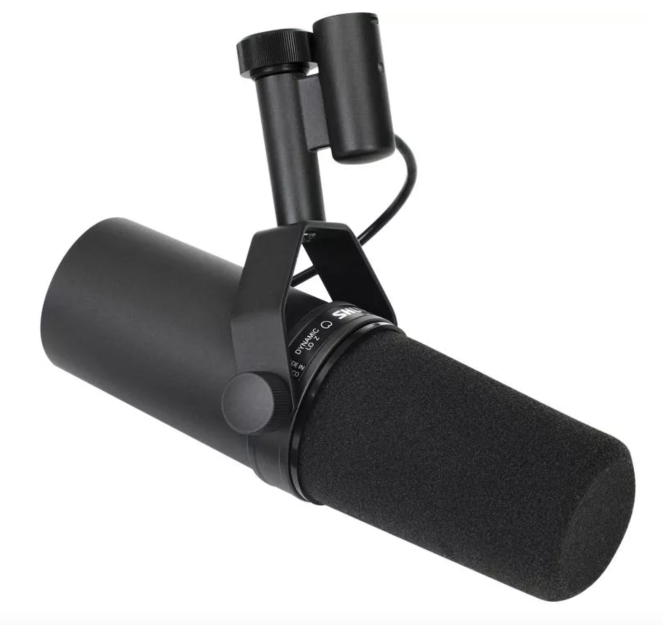
SPECS
- Type: Dynamic microphone
- Pattern: Cardioid
- Connectivity: XLR
Shure SM7B is the studio favorite of many, many stars, from Keith Urban to Michael Jackson and more. It’s very sturdy, has a mid-forward, focused sound as a dynamic mic, and can take extremely high-volume sources.
It tends to “cut through the mix” thanks to its EQ curve, not unlike its sibling, the SM57. It has its own pop filter, and at $399, you can own one, plus an affordable large diaphragm condenser, and be done with it.
The B stands for broadcast, by the way, as it was designed for radio use. So, whether you're a DJ or news anchor, consider this mic for your recording studio.
A feature that's a huge selling point for broadcast professionals is the internal shock mount. It reduces handling noise and vibrations, which makes it a safe pick for noisy newsrooms or college radio stations, which makes it the best Shure microphone for these environments.
The studio microphone has a frequency response range of 50Hz to 20kHz and a sensitivity of -59 dBV/Pa.
You can switch between two different tone settings, flat and presence boost. "Flat" is neutral and natural, and the presence boost provides more clear vocals.
Podcasters feel like it's helped them step up their audio quality. Overall, it's a great vocal microphone for podcasters and multimedia journalists.
6. Best XLR Under $330 – Aston Microphones Spirit
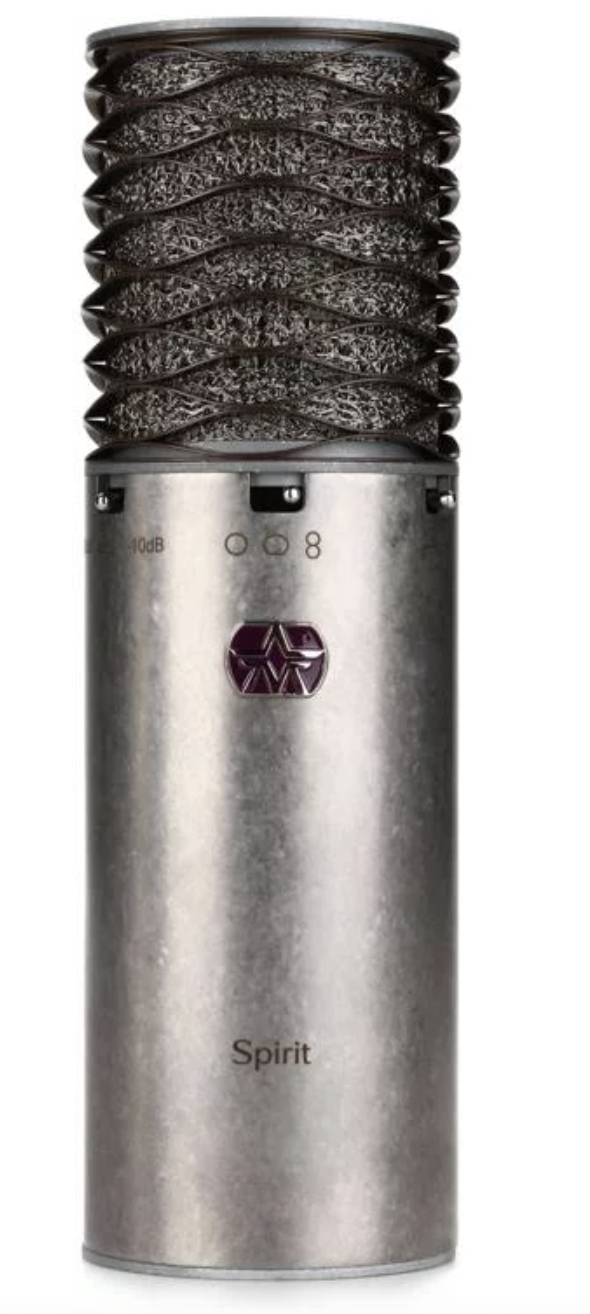
SPECS
- Type: Condenser mic
- Pattern: Multipattern
- Connectivity: XLR
A recent entry into the vocal mic game, the Spirit is quickly gaining fans all over the globe. It’s attractive and solidly built in the UK and excels on just about any source. It’s a large diaphragm, multi-pattern condenser, so you won’t have any trouble finding myriad ways to use it in the studio.
It’s a little more “forward” in the upper-frequency ranges than some other mics on this list and maybe a touch sibilant; however, it doesn’t suffer from proximity effect like many other popular microphones.
The studio vocal microphone has a frequency response range of 20Hz to 20kHz and a -20 dB pad switch, and a low-cut filter switch for flexibility over the microphone's sound.
It has a built-in pop filter to reduce plosives, so whether you're singing or recording a podcast, you can rest easy knowing plosives won't ruin the take or episode.
Users love using this vocal microphone for drum overheads as well—the band will love this mic.
7. A Versatile Mic for Vocals & Drum Overheads – Beyerdynamic M160
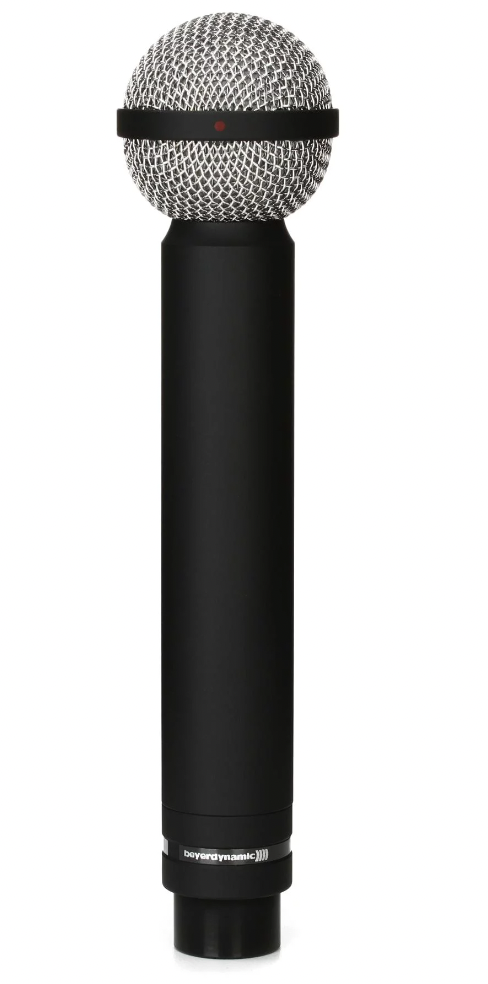
SPECS
- Type: Ribbon microphone
- Pattern: Hypercardioid
- Connectivity: XLR
You may even see old photos of David Bowie using one in concerts. It’s fairly flat response-wise, but that can be a good thing on some sources, and on vocals, it will be very forgiving when it comes to sibilance.
There’s a certain “realism” to ribbon mics, and it just might be the trick for certain particular voices. Ribbons also generally take to EQ very well, even radical EQ moves in post.
At $799, it’s a very reasonable expense considering its long pedigree, and it’s always good to have at least one ribbon in your cabinet.
It has a frequency response range of 40Hz to 18kHz and a sensitivity of -56.0 dBV/Pa. Its low mass ribbon construction and low impedance output help to provide excellent transient response and clarity.
It's super compact and unique, users find it aesthetically pleasing. But since it's small, it'll also come in handy for drum overheads, guitar amps, and more.
8. Best Shure Mic Under $100 – Shure SM58 Cardioid Dynamic Vocal Microphone
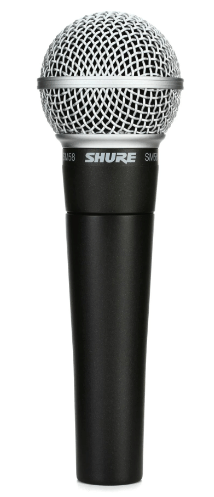
SPECS
- Type: Dynamic microphone
- Pattern: Cardioid pickup pattern
- Connectivity: XLR
Just about every singer-songwriter has the SM58 handheld mic in their mic collection. It's a dynamic mic, making it very sensitive. Since it's a dynamic mic, it'll come in handy for gigs and also for singers with loud and aggressive vocals.
The cardioid pattern will reject sounds from the side and rear, making this a great pick for sound isolation. It has a frequency response range of 50 Hz to 15 kHz, which is ideal for a clear and natural sound quality.
Some may say this is the only versatile microphone you need. It's definitely one of the best, and users are always impressed by how long these mics last.
9. Best Audio Technica Mic Under $100 – Audio-Technica AT2020 Cardioid Medium-diaphragm Condenser Microphone
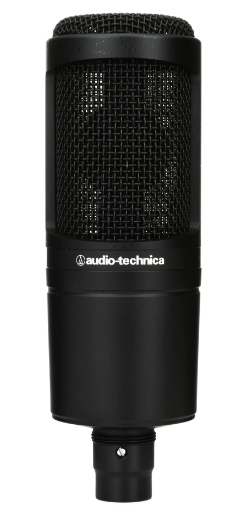
SPECS
- Type: Cardioid
- Pattern: Condenser
- Connectivity: XLR
The Audio-Technica AT2020 is the studio microphone you'll often get recommended to use as a beginner singer-songwriter. It's an entry-level music production favorite, and it's under $100. It's very affordable, but it doesn't lack quality.
Not only is it great for vocals, but it'll record acoustic instruments as well. It has a high sound pressure handling for picking up loud sounds without distortion. It has a frequency response range of 20 Hz to 20 kHz, which is the recommended coverage for recording.
Overall, it's a great vocal microphone for your home studio and also for professional use. Some compare it to high-end mics over $1,000!
10. Best Studio Versatility – Lewitt MTP W950

SPECS
- Type: Condenser
- Pattern: Multipattern
- Connectivity: XLR & Wireless compatible*
* For more details on microphone compatibility, check out the list of compatibility here: List of compatible systems
As a vocalist, you might be looking to move your creative ideas out of the studio and into a live situation, and we have the microphone just for you.
The MTP W950 from Lewitt is a great all-around microphone that suits the needs of live and studio performers. If you find yourself on stage with a lot of bleed from other performers on stage, then you do not need to worry with this microphone.
It has an industry-leading 90% rear rejection, meaning that there will not be any pesky instruments sneaking into your vocal performance through your microphone.
Unlike most stage microphones, which tend to be dynamic microphones, the MTP W950 is a condenser microphone that will preserve and present your live performance to a high quality as if you were recording in a studio.
The MTP W950 is highly regarded by professionals within the industry and has been used by the likes of The Rolling Stones, Kehlani, and Anderson .Paak.
This versatile microphone is easily adaptable to both the live music experience and offers a top-end recording in a studio setting as well and is easily a viable option for artists looking for a flexible microphone.
11. Best AKG Mic – C7 Supercardioid Condenser Handheld Vocal Microphone

SPECS
- Type: Condenser
- Pattern: Supercardioid
- Connectivity: XLR
The AKG C7 is a fantastic vocal microphone. While it's mostly geared for gigs, it'll make a great recording mic as well. The polar pattern is perfect for noisy environments; it'll capture sound from the front and minimize lots of feedback.
The mic is super sensitive and has a frequency response range of 20 Hz to 20 kHz. It'll capture all the details, minus the ones you don't want. The built-in shock mount reduces handling noise, and there's a multilayer pop filter to reduce plosives and wind noise.
In terms of durability, it's a solider. This is a mic that also gets lots of praise for its rugged zinc alloy construction. It'll survive the roughest of gigs.
Users love using this condenser mic for outdoor gigs, so if you want a reliable mic for summer shows, this is it.
12. A Rode Favorite – Rode S1 Supercardioid Condenser Handheld Vocal Microphone - Satin Nickel
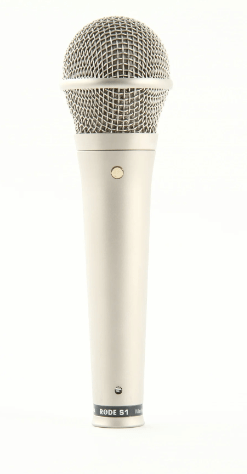
SPECS
- Type: Condenser mic
- Pattern: Supercardioid
- Connectivity: XLR
Rode is king when it comes to vocal mics. The Rode S1 is a super cardioid mic built for the studio and stage. Sweetwater says it can record during the day and hit the gig at night.
Some features you'll like are the all-metal construction, satin nickel finish, custom-designed integral 'plosives' screen, and the low noise circuitry. It has a high level of sensitivity and a frequency response range of 20 Hz to 20 kHz.
Overall, we think it's a great fit for reducing noise. Between the pattern and shock mounting system, you won't have much feedback and vibration.
Users can't believe how great this condenser microphone sounds in the studio and on stage. If you want a reliable mic for both settings, you'll enjoy using the Rode S1.
Best Microphones for Vocals Buyer's Guide
All microphones are not made equal. We'll cover the different types of microphones you'll encounter when shopping for a mic, as well as the types of polar patterns, frequency response ranges, budgets, and more. As for the connectivity, apart from XLR, one of the quality wireless microphones may also turn out to be your preferred option.
With these tips, finding the best microphone for vocals is a walk in the park.
Microphone Type
There are a few types of vocal microphones to consider—condenser, ribbon, and dynamic mics. Condensers are popular when it comes to vocals since they are sensitive and very clear.
Dynamic mics are as well, but they're preferred for gigs since they can handle high sound pressure levels. Ribbon mics are awesome, too, but they're more expensive.
Polar Pattern
A cardioid pickup pattern is the way to go. Cardioid patterns reject noise from the sides and rear, so they're great for one person. An omnidirectional vocal microphone isn't a bad option if 2 people are recording on the same mic.
Frequency Response
A frequency range between 20 Hz to 20 kHz is ideal since this is the range humans can see.
Sensitivity
High sensitivity is great for recording quiet and soft performances, and low sensitivity is better for louder singing styles.
Noise Floor
Noise level refers to the level of background noise picked up by the mic when no sound is recorded. A low-noise floor is a must to reduce the unwanted background noise in the recording.
Budget
We have mics on this list that cost $100, and we have some that cost over $5,000. You can have a quality budget mic for your home studio, but if you're looking for professional-grade mics for studio recording, you may want to spend more to get the most out of your session.
Frequently Asked Questions (FAQs)
What type of microphone is best for recording vocals?
Condenser mics are great! They're sensitive and do a fantastic job capturing details in a singer's voice. Dynamic mics are also a good choice if the singer is loud.
What is phantom power?
A DC voltage is sent through the mic cable to power condenser microphones. Dynamic mics do not require external power.
Do I need a pop filter?
Yes, if you want to prevent plosives from sounds like "p" and "t," they can be very helpful.
Verdict
So that’s just a sample for you to consider if you’re looking at quality vocal microphones to up your game or just to add something new to your studio for versatility. Sometimes, you might need a combination of these.
Many of these mics can be used on any instrument, so you’re not wasting your money to add them to your arsenal, whether you’re a home recording enthusiast or even own a full, commercial studio.
If you want a good microphone for under $400, the Shure SM7B is a great pick. Whether you're a singer, news anchor, or podcaster, it's a fantastic mic that'll blow plenty of competitors out of the water.
As for high-end mics for the ladies, you can't go wrong with the Lauten Atlantis. And if you can stretch your budget, a multipattern mic from Austrian Audio OC818 is ideal.
Want to learn more about microphones? See Our Picks for Budget Boom Mics.
Photo Courtesy Sweetwater
